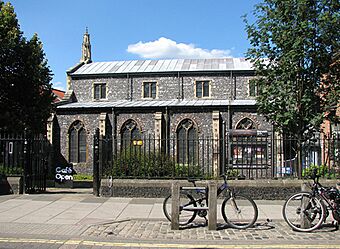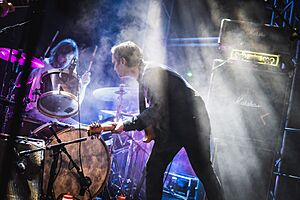Norwich Arts Centre facts for kids

The Arts Centre in 2010
|
|
| Former names | The Church of St Swithin |
|---|---|
| Address | St Benedict’s Street Norwich NR2 4PG |
| Location | Norwich |
| Coordinates | 52°37′54″N 1°17′16″E / 52.63161°N 1.28776°E |
| Capacity | 300 standing 120 seated |
| Construction | |
| Built | 1349 |
| Opened | 1977 |
The Norwich Arts Centre is a cool place in Norwich, England. It's a spot where you can enjoy live music, watch plays, and see art. It's located on St Benedict's Street. This centre can hold up to 300 people for standing concerts. For events where people sit, it can fit 120. In November 2014, a magazine called NME said it was "Britain's Best Small Venue."
Contents
History of the Arts Centre
How it Started
In 1976, some people in Norwich wanted to create a new place. They wanted a venue for different kinds of art and performances. With help from the Norwich City Council, they opened a place in 1977. It was in an old carpet factory on St Benedicts Street. They called it "Premises."
Moving to a New Home
The Arts Centre moved to its current home in 1980. This new home was an old church called St Swithin's Church. It has been there ever since. Today, the centre works as a charity. This means it's a non-profit organization that helps the community.
Famous Visitors
Even though it's a small venue, many famous bands and comedians have performed here. Some of the bands include Nirvana, Oasis, Muse, and Coldplay. Other well-known groups like The Stone Roses and Kasabian have also played. Comedians such as Jack Dee, Noel Fielding, and Frank Skinner have made people laugh at the centre.
St Swithin's Church: The Building's Story
An Old Church Building
The building that houses the Norwich Arts Centre is a very old church. It is named after Saint Swithun. The church was built in 1349. It's possible that an even older church from the Anglo-Saxon times was on this spot before.
Changes Over Time
The area around the church was once very rich. There were four medieval churches close together. But by the 1800s, it had become a poor area. St Swithin's Church was closed in 1881 because it was no longer needed. In 1882, the church's tower was taken down because it was unsafe. A smaller bell-cot was put in its place later.
The building was used as a church again from 1883 to 1891. After that, it started to fall apart.
New Purpose and War Years
In 1905, a clergyman named John Sawbridge raised money. He wanted to reopen the church for the poor people in the area. Enough money was raised to build a large room next to it in 1908. This room was used as a mission and a school. During World War II, this building was the main office for the local Home Guard. The Home Guard was a group of volunteers who defended Britain.
Becoming the Arts Centre
By 1951, the church was not used much again. This was because fewer people lived nearby. In 1954, the church was given a special status as a Grade I Listed building. This means it's a very important historical building. It was used as a furniture warehouse for a while. Then, in 1980, the Arts Centre took it over. The church part became the main performance hall. The old schoolroom became a space for art shows and a cafe.
Inside the Building
Not much of the original church interior is left. When it was changed into an auditorium in the early 1980s, many church features were removed. Some old medieval features, like special seats for the choir, are no longer there. However, ten old monuments still remain. The oldest ones are for Sibilla Skottowe (who died in 1657) and Anne Skottowe (who died in 1662). There is also a monument for William Abbott (1754-1818). He was a soldier who fought in the American War of Independence at the Battle of Bunker Hill.
See also
- The Waterfront, Norwich
- Norwich Cinema City
- Norwich Playhouse


